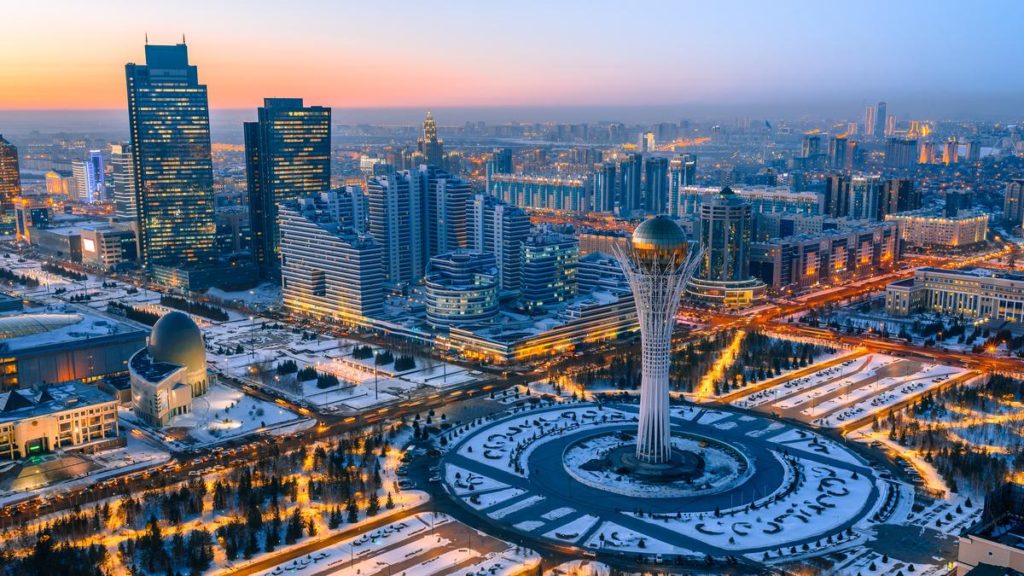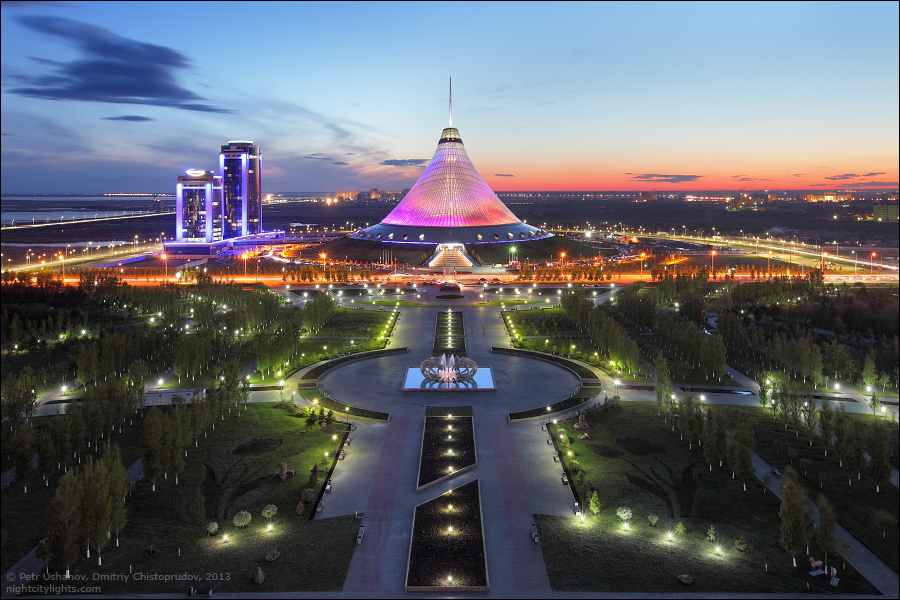What to know before you travel to KAZAKHSTAN
General information
Located in the central Asia, Kazakhstan occupies an area of 2.7 million square kilometers. It is the ninth largest country in the world. Also, it is the largest landlocked country in the world and twice as compared to the size of four Central Asian states. It is enclosed by Russia, Kyrgyzstan, Turkmenistan and Uzbekistan, Caspian Sea and Russia and China. The country has a coastline of about 1,894 km of the Caspian Sea.
Capital: Astana
Largest cities: Almaty, Astana, Shymkent, Karagandy
Languages: Kazakh and Russian are spoken by the local population; English is usually used by staff of major tourism companies and hotels.
Currency: the national currency is Tenge (KZT); US Dollars, Euro and other currencies can be easily exchanged in banks and exchange bureaus.
Weather: The best season to travel to Kazakhstan is from March to November, since winter in Kazakhstan is usually cold; however snowy winters might be perfect for winter sports. Temperature in summer can reach up to +40'C and more in some regions.
Food: Kazakh cuisine, Central Asian, Russian cuisines, as well as Italian, Turkish, Korean restaurants are popular in Kazakhstan. Organic and naturally grown ingredients are usually used to prepare meals, which give them an exceptionally rich taste.
Kazakhstan - The Land of Wonders
Kazakhstan is a unique region in the world, because of its history, geographical position and size. Being the world’s 9th largest country and located in the centre of Eurasia, it is also the largest landlocked country in the world. These resulted in a specific climate and a peculiar natural system of the country, which seems to absorb the brightest examples of landscape of both continents. In addition, complicated history of Kazakh people and constant interaction of nomadic lifestyle with settled people in South Kazakhstani ancient cities, have lead to a unique and authentic culture of Kazakhstan.
These peculiarities have created an opportunity to develop various and diverse offers in Kazakhstan travel and tourism industry, which include authentic cultural tourism, nature-based activities, including ecotourism, birdwatching, etc. in national parks and protected areas, skiing or trekking in mountains, water sports, sunbathing and swimming in lakes and rivers of Kazakhstan, and many others.
Nature-based tourism
Diversity of natural areas has contributed to rich flora and fauna of Kazakhstan. The country is a habitat for about 122 mammal species, 500 species of birds and 107 species of fish; and over six thousand species of plants grow in the region. In order to preserve such a rich world of plants and wildlife, a network of national parks and nature reserves were established in the country. Recently, these protected areas have become accessible to visitors.
The most famous ones among tourists include Aksu Zhabagly Nature Reserve, which is a habitat of snow leopard and other rare animals, and is also known as a Kingdom of Tulips, where tulips are believed to originate, long before they were introduced in Holland; Korgalzhyn Nature Reserve is famous for its pink flamingos and other rare species of wildlife, and popular among bird-watchers; Altyn Emel National Park is interesting for its mystery of Singing Dune; Katon-Karagay National Park is a habitat of marals (red deers), unossified antlers of which are used as a precious medicine.
Mountains: Trekking and winter sports
A range of high, middle and low mountains, such as Tien Shan, Altay, Ulytau, Kazygurt, etc. have a beautiful nature attracting tourists from all over the world. Tien Shan Mountains is the highest among them (with the highest peak of about 7000 metres), and Almaty, the largest city of Kazakhstan, is located at its bottom. Thus, an easy access to marvelous landscapes for tourists interested in trekking and winter sports is available from Almaty city.
Most popular climbing routes are located in the Small Almaty Valley and Bogdanovich Glacier. Attractions of these places include Pogrebetsky Glacier (4,231 meters), Tuyuc Su (4100 m), Ordzhonikidze (3980 m) peaks, and many others. In addition, high mountains of Kazakhstan are ideal for winter sports. There is no wonder that Kazakhstan hosted Winter Asian Games in 2011: one of the priorities of the country has been propaganda of winter sports.
A unique sport complex Medeu (sometimes spelled as Medew or Medeo), with a skating rink popular among tourists, was built in 1950’s, at 1691 metres above sea level, which makes it the highest skating rink in the world. A sophisticated artificial refrigeration system enables to keep high quality ice coverage over 8-months of the year. Another major winter sport attraction of Kazakhstan is Shymbulak (Chimbulak) ski resort, also located not far from Almaty. Snow lies in these places from November till May; however, sunny weather is usually registered there during more than three hundred days each year. The resort hotel can accept up to 114 tourists.
Lakes and rivers: water sports, sunbathing and health resorts
Kazakhstan is not only steppes and mountains; it is also a country of rivers and lakes. Lakes among the steppes are usually like an oasis among empty deserts.
Coast of the biggest lake in the world – Caspian Sea is perfect for sunbathing, swimming and fishing. The largest number of reservoirs is concentrated in the south-east part of the country, in the region with a symbolic name Zhetysu - “Seven Rivers”. Almost all the rivers of Zhetysu belong to the basin of Lake Balkhash, which is also a popular tourist destination for its health centers and recreation camps. Besides health resorts, rafting in mountain rivers for extreme tourists, boating and sailing in lakes are only a few examples of activities offered for tourists in Kazakhstan.
Culture: ethnotourism
Unique culture of Kazakhstan is a reason to travel to Kazakhstan for many tourists. Almost in every corner of the republic, a visitor, interested in real life of Kazakh people - their traditions, rituals, art and culture, will find many things of interest. These include museum complexes, ethno villages, depicting traditional lifestyle of Kazakh people, historical sites of medieval cities and many others.
For example, tourists are offered to experience traditional lifestyle of Kazakhs, to try national dishes and to interact with the local people in Shabanbay Bi Village, situated in Kyzylaray Mountains, Central Kazakhstan. Zhambyl Zhabayev museum complex in Almaty region includes a house with a garden, where the poet lived in XIX-XX centuries and a mausoleum. This is a visual representation of not only Zhambyl’s life, but also of a whole era in which the poet lived and worked. South Kazakhstan is famous for ancient cities located at the routes of the Great Silk Road with historical monuments and other sites.
Ethno-memorial complex Map of Kazakhstan - Atameken, located in Astana, is the largest ethnographic park in Kazakhstan and a unique outdoor museum. Cities and landscapes of the country, as well as mini copies of main attractions and historical sites can be found on the map.
Largest cities of Kazakhstan
ASTANA: Capital of the Republic of Kazakhstan
Population: The 2014 census reported a population of 835,153 within the city, making it the second-largest city in Kazakhstan.
Climate: sharply continental: moderately hot summer and long-lasting frosty winter.
At present the capital of the country carries out trading with 121 countries around the world, including capitals with which twin-town relationships are maintained: Moscow, Minsk, Kishinev, Kiev, Kazan, Seoul, Riga, Warsaw, Budapest, Baku, Cairo, Bangkok, Berlin, Vilnius, Ankara, Ushak, Tashkent, Beijing, etc.
It was once said that “the West is the West; the East is the East and they will never be together”. In Kazakhstan there is a city which disproves this saying that seemed irrefutable.
The world’s best architects built Astana. The architectural concept of the city was based on President Nursultan Nazarbayev’s idea that the city should have a Eurasian outlook.
The author of the general plan of Astana was the famous Japanese architect, Kisho Kurokawa, who designed the Van Gogh museum in Amsterdam, the International Airport of Kuala Lumpur and the national ethnological museum in Osaka.
The architectural ensembles created in accordance with Kurokawa’s general design combine modern design and oriental flavor. This makes the city unique. The beauty and the height of buildings in the city are comparable with Tokyo, New York and Dubai. Norman Foster designed and built Astana’s unique House of World’s Religions, the Palace of Peace. The architect’s team also built the capital’s new entertainment center, the “Khan Shatyr”.
The city’s appearance changes fast as it continues its dynamic development. The city also looks different at night, with beautifully illuminated buildings, street lights, garlands, colorful fountains on the River Ishim, nightlights along the bank, bright shop windows, bars and nightclubs.
ALMATY: The Bridge between Asia and Europe
Almaty (Alma-ata) is largest city in Kazakhstan with a population of 1,421,868 (at 1st of August 2010) with about 9% of the countries population located in one city, it is certainly a hustling and bustling place to be. It also used to be the former capital of the country, until 1997 when it moved to Astana.
The city is located in the heart of the Eurasian continent, in the south-east of Kazakhstan, at the foot of the Tien Shan mountains at an elevation of 700 to 1100 meters above sea level.
The climate of the city - is sharply continental, with large temperature fluctuations, not only in the year, but days.
The town is buried in the green - 10 000 hectares of its territory is occupied by parks, trees, parks and gardens
Almaty is still the centre of commerce for Kazakhstan, with the stock exchange and largest banks located there.
Almaty literally means 'city of apple trees', and, because of its relatively mild climate, it has a wide range of apple trees. The Almaty area is said to be the genetic home for many varieties of apples and the area is often visited by researchers and scientists from around the world, in order to learn more about the complex systems of genetics, and also to discover the true beginnings of the domestic apple. The Turkic name for apple is Alma and Ata meaning forefather, which could lay it open to be possibly the origin of the Apple (The garden of Eden).
The city certainly has a spectacular beauty, whether or not it was the Garden of Eden, and is located in the foothills of the Trans-Ili Alatau in the extreme southeast of Kazakhstan. The backdrop of mountains against the taller buildings makes a dramatic and impressive sight and was the center for the Asian Winter games in January 2011.










